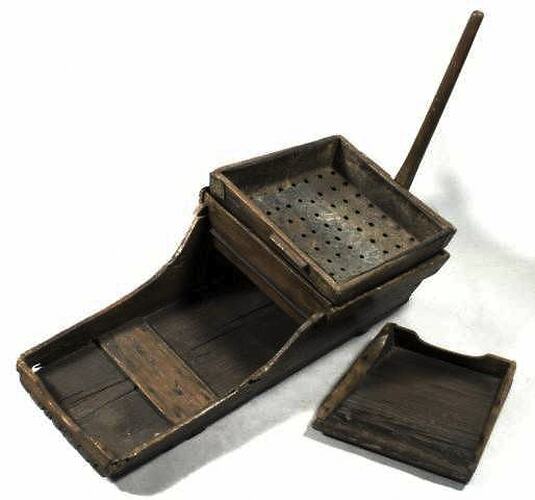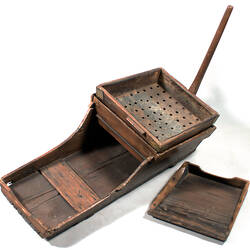Summary
Wooden miner's cradle with metal sieve used to separate gold or other heavy minerals from soil and water, dating to before 1900.
Washdirt and water were tipped into the sieve at the top while the cradle was rocked. The oscillating motion washed away sand and fine particles, leaving the gold trapped behind ridges across the bottom. Large rocks and gravel caught by the seive were discarded by hand.
Physical Description
Cradle made from a variety of different kinds of wood; well-worn and patched. Consists of a rectangular base on two curved rockers, made of wood with a metal base; there is a long wooden handle at one end, which is moved from side to side to rock the cradle on its rockers. At the handle end the base is high, with a piece of wood across the cradle (reinforced by metal) forming a rectanglar compartment. A wooden drawer, with corners reinforced by metal and a metal sieve base, fits into the top rectangle. There is also a wooden scoop, edged in pine, pitted and well worn at the end, which was used to scrape soil and water across the sieve, from whence it fell into the base and was washed out, leaving metal in the base at the end furtherest from the handle.
More Information
-
Collecting Areas
-
Acquisition Information
Purchase
-
Date Made
-
Date Used
-
Inscriptions
The initial 'G' has been carved into the scoop, and at the end of the base.
-
Classification
Mining & metallurgy, Exploration & prospecting - alluival gold
-
Category
-
Discipline
-
Type of item
-
overall dimensions
50 cm (Length), 118 cm (Width), 94 cm (Height)
-
Exhibition Collection Management
1085 mm (Length), 493 mm (Width), 870 mm (Height)
-
Dimensions
1120 mm (Length), 485 mm (Width), 855 mm (Height)
Measurement From Conservation. Measuring Method: Maximum dimensions
-
Keywords


